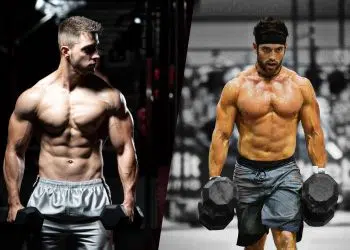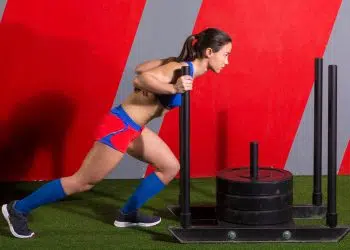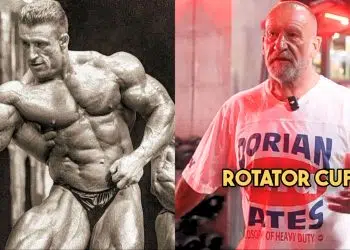Bodybuilders have a saying: If you want to grow, you gotta row. Rows are crucial for building a bigger, stronger back. They also say that squats are the king of exercises and are all but compulsory if you want muscular, powerful legs.
But what exercise should you do if you want massive shoulders?
The simple answer is overhead presses!
Pressing a heavy weight overhead will test and develop your upper body, arm, and core strength. In fact, up until the 1970s, the overhead press was one of the disciplines of Olympic lifting and still features in strongman competitions in various guises, including log presses, axle presses, and the Viking press.
Back in the gym, there are many different overhead pressing variations to choose from, and each one is a great way to develop the upper body of your dreams.
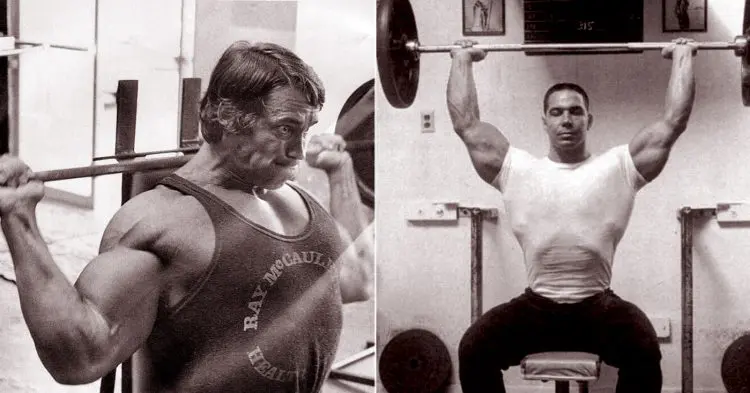
But, for this article, we’re going to discuss the push jerk, push press, and strict press so you can pick the right one for your needs.
Level Up Your Fitness: Join our 💪 strong community in Fitness Volt Newsletter. Get daily inspiration, expert-backed workouts, nutrition tips, the latest in strength sports, and the support you need to reach your goals. Subscribe for free!
The Push Jerk
The push jerk is an explosive strength or power exercise. It’s a highly technical lift used chiefly by athletes to increase sports performance.
With the push jerk, you not only use your legs to drive the weight overhead but also re-bend your knees to drop below the bar so you can catch it overhead in a partial squat before standing up to complete your rep.
This allows the lifter to hoist heavier weights by making the most of their powerful leg muscles. However, it also takes stress off the upper body, which means, instead of being a pure shoulder exercise, the push jerk becomes a full-body exercise.
How to do Push Jerks
- Stand with your feet between shoulder and hip-width apart.
- Using an overhand grip, rack and hold your barbell across the front of your shoulders. Your hands should be just outside shoulder-width apart. Raise your elbows slightly, so they are in front of the bar.
- Brace your core, pull your shoulders down and back, and lift your chest.
- Without leaning forward, bend (dip) your knees and descend into a quarter-depth squat. Imagine you are setting up for a jump. Keep your heels on the floor.
- Extend your legs and use this momentum to help you drive the bar up and off your shoulders. Rise up unto your toes if you wish.
- Bend your knees again as you extend your arms and catch the bar in a partial squat with your arms straight.
- Stand up and hold the bar overhead with your knees, hips, and shoulders extended.
- Lower the bar back to your shoulders and repeat.
Push Jerk Pros
Is the push jerk the right overhead pressing exercise for you? Consider these pros and then decide:
A full-body exercise – the push jerk involves your lower and upper body. That’s usually how your body works in nature. The push jerk is a very functional exercise.
Improves coordination and timing – the push jerk is as much about timing and coordination as it is muscle strength and power. Doing this exercise will enhance athleticism and agility.
Develops power – power is your ability to generate force quickly. It’s a critical part of most sports. If you want to run faster, jump higher, or punch harder, the push jerk could help.
A prerequisite for Olympic lifting– the push jerk is closely related to the split jerk, which is part of the Olympic clean and jerk. If you want to become a better Olympic lifter, the push jerk will help.
Push Jerk Cons
There are also a couple of disadvantages to push jerks:
Hard to learn – there aren’t many overhead pressing exercises that are more technically challenging than the push-jerk. As such, it’s not an easy lift to learn and master and not suitable for beginners.
Not so good for hypertrophy – while the push jerk allows you to lift heavy weights, using your legs means there is less load on your upper body than other types of overhead press. As such, if you are pressing for bigger delts, this exercise may not be your best choice.
Risk of injury – the combination of heavy weights and rapid movements means that the push jerk could cause serious injury. Therefore, it is essential to warm up thoroughly before doing this exercise and perform it with good form. Even then, there is still a risk of injury.
The Push Press
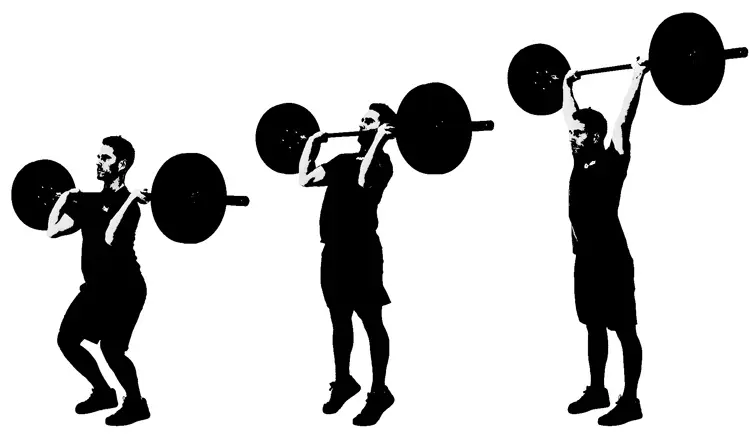
The push press is a slightly simpler version of the push jerk. You still use your legs to help push the weight overhead, but you don’t re-bend your knees to catch the weight in a shallow squat. Instead, you receive the bar standing upright with your knees and hips extended.
Compared to the strict press, you should be able to lift more weight with push presses, as your legs provide a significant amount of assistance. However, your arms and shoulders must generate more force than with push jerks, making this variation more upper body dominant.
How to do Push Presses
- Stand with your feet between shoulder and hip-width apart.
- Using an overhand grip, rack and hold your barbell across the front of your shoulders. Your hands should be just outside shoulder-width apart. Raise your elbows slightly, so they are in front of the bar.
- Brace your core, pull your shoulders down and back, and lift your chest.
- Without leaning forward, bend your knees and descend into a quarter-depth squat. Imagine you are setting up for a jump. Keep your heels on the floor.
- Rapidly extend your knees and hips and use this momentum to help you drive the bar up and overhead.
- Receive the bar overhead with your knees, hips, and arms extended.
- Lower the bar back to your shoulders and repeat.
Push Press Pros
Are push presses the right overhead exercise for you? Consider these pros and then decide:
A full-body exercise – like the push jerk, the push press uses your upper body and lower body simultaneously, making it a very functional exercise.
Good for developing power – the push press is an explosive exercise. The aim is to try and push the bar up quickly. This makes the push press good for athletes from all sports.
Lift heavier weights – using your legs to initiate each rep means you’ll be able to lift heavier weights overhead. This could mean you get stronger, faster. Lowering the weights under control (i.e., eccentrically) may also enhance hypertrophy. You should be able to lift as much as 30% more with push presses compared to a strict overhead press.
A logical progression toward doing push-jerks – with only one knee dip, the push press is easier to learn than the push jerk. As such, it’s a useful preparatory exercise.
A way to do forced reps alone – with a set of strict presses, you’ll reach a point where you cannot perform any more reps. Your deltoids and triceps will be too fatigued to generate the force necessary to push the weight overhead. However, doing a few push press reps means you can extend your set beyond this point, potentially stimulating more muscle growth.
Level Up Your Fitness: Join our 💪 strong community in Fitness Volt Newsletter. Get daily inspiration, expert-backed workouts, nutrition tips, the latest in strength sports, and the support you need to reach your goals. Subscribe for free!
Push Press Cons
There are also a couple of disadvantages to push presses:
Requires good coordination – even though there is just one knee dip, the push press is still a pretty technically demanding lift. As such, some beginners may find it hard to learn.
Allows you to lift more weight – lifting more weight is a double-edged sword. On the one hand, it means you’ll get stronger, but, on the other hand, it also places more stress on your joints. You also need to be strong enough to lower the bar under control.
May not be so useful for hypertrophy – like the push jerk, the push press allows you to lift heavier weights by using your legs. This could mean there is less load on your upper body. As such, if you are pressing for bigger delts, this exercise may not be your best choice. However, you can mitigate this problem by emphasizing the negative or lowering part of each rep or doing push presses immediately after strict presses.
The Strict Press
As its name suggests, the strict press is done without any assistance from your legs. Instead, your legs remain rigid, and your upper body does all the work. The strict press is sometimes called the military press.
The difference is that military presses are done with your heels together like you are standing to attention. However, it’s usually more comfortable and stable to do strict presses with your feet shoulder to hip width apart.
The strict press is the cornerstone of all overhead pressing exercises. As such, it’s the one that most people need to learn and master before progressing to the push jerk and push press.
How to do the strict press
- Stand with your feet between shoulder and hip-width apart.
- Using an overhand grip, rack and hold your barbell across the front of your shoulders. Your hands should be just outside shoulder-width apart. Raise your elbows slightly, so they are in front of the bar.
- Brace your core, pull your shoulders down and back, and lift your chest.
- Without bending your knees, press the weight up and overhead to arms’ length.
- Lower the bar back to your shoulders and repeat.
Strict Press Pros
Is the strict press the right shoulder exercise for you? Consider these pros and then decide:
Easy to learn – with much less coordination involved, the strict press is easier to learn than the push press or push jerk. As such, it’s a better exercise for most beginners.
Overload your upper body – with no leg drive, the strict press is an upper-body exercise and not a full-body exercise. If you want to emphasize your upper body and not use your legs as well, the strict press is a better choice than push presses and push jerks.
Good for strength and hypertrophy – strict presses put all the load on your upper body, keeping your muscles under tension for the entire range of motion. You’ll need to rely on upper body muscle power to raise and lower the weight. In contrast, during push jerks and push presses, your legs help you lift the weight, which could make them less effective for building upper body muscle strength and size.
Relatively safe – strict presses are done with a slower tempo and lighter weights than push presses and push jerks. As such, it may be a safer choice for some exercisers. But, as it’s a more straightforward movement, there is also less to go wrong.
A necessary steppingstone for push presses and push jerks – the strict press teaches you how to lift a weight above your head correctly and safely. As such, it’s a prerequisite for push presses and push jerks. It will also help develop the strength necessary to perform these more advanced exercises effectively.
Strict Press Cons
There are also disadvantages to strict presses:
No assistance from your legs – with strict presses, when your muscles fatigue, your set will come to a grinding halt. With the leg-assisted variations, you’ll be able to pump out a few more reps after your upper body starts to fail.
Push Jerk, Push Press, and Strict Press – Which One Should You Do?
According to the law of specificity, your body adapts according to the stresses placed on it. Therefore, if you are training for something particular, your workout needs to match your goals. As such, the right overhead press variation depends on what you are training for:
For beginners – master the strict press before attempting the push press or push jerk. The strict press will develop the strength and technique you need to do these more challenging exercises correctly and safely.
For bodybuilders – building muscle requires a combination of muscle tension and metabolic stress. The strict press is arguably the best way to achieve this. However, the push press with an emphasized negative could also be helpful as it will allow you to train with heavier weights.
For strength – the push jerk is very much a power exercise. The push press is not far behind. While both exercises will increase your strength, the slower strict press is probably better for building pure strength, especially if you want to emphasize your upper body.
For athletes – most athletic endeavors involve your upper and lower body working together. Subsequently, athletes will benefit more from push presses and push jerks than the strict press. Push jerks are the most technically demanding exercise and so are arguably the best choice for sportspeople.
For fat loss – any of these overhead press exercises could be included in fat loss workouts. But, in terms of caloric expenditure, the push jerk involves the most movements and muscles per rep, so it could be the best of the three for fat loss. However, this advantage is minimal.
For safety – lifting heavy weights explosively puts a lot of stress on your muscles, joints, and connective tissues. As such, the strict press is potentially safer. That said, even the strict press can be dangerous if you use too much weight or perform it with improper technique.
Strict press, Push Press, Push Jerk Mechanical Drop Set
Are you unable to choose between these three great exercises? Or maybe you want to do all three just for fun? Try this overhead press mechanical drop set. In simple terms, you’re going to do each exercise to failure, using increasing amounts of leg drive to pump out more reps.
- Strict press – load up a barbell with about 60-70% of your 1RM. Without using your legs at all, push out as many reps as you can. On reaching failure, immediately switch to the next exercise…
- Push press – give your upper body some assistance and do another couple of reps. Dip your knees and drive the bar up overhead. Continue to failure, and then move to your final exercise…
- Push jerk – while you probably won’t get many more reps, dipping your knees for a second time means you won’t have to push the weight up as far to complete each one. Continue to failure, lower the bar to the floor, and congratulate yourself on a job well done!
Wrapping Up
Forget the bench press; if you want a strong, muscular upper body, overhead presses are where it’s at! That’s not to say the bench press is a bad lift – that would be sacrilegious. However, the overhead press is every bit as effective for building upper body size and strength.
There are loads of overhead press variations you can do, but strict presses, push presses, and push jerks are three of the best.
Do them all in rotation, or pick the one that best fits your goals. Either way, pressing heavy weights overhead is one of the most satisfying, rewarding things you can do in the gym.


